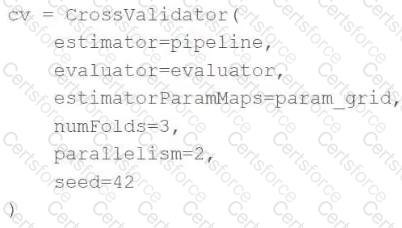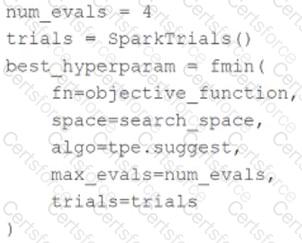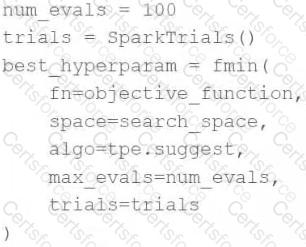Which of the following evaluation metrics is not suitable to evaluate runs in AutoML experiments for regression problems?
A data scientist has a Spark DataFrame spark_df. They want to create a new Spark DataFrame that contains only the rows from spark_df where the value in column discount is less than or equal 0.
Which of the following code blocks will accomplish this task?
A machine learning engineer is trying to scale a machine learning pipelinepipelinethat contains multiple feature engineering stages and a modeling stage. As part of the cross-validation process, they are using the following code block:

A colleague suggests that the code block can be changed to speed up the tuning process by passing the model object to theestimatorparameter and then placing the updated cv object as the final stage of thepipelinein place of the original model.
Which of the following is a negative consequence of the approach suggested by the colleague?
A data scientist is using the following code block to tune hyperparameters for a machine learning model:

Which change can they make the above code block to improve the likelihood of a more accurate model?
A data scientist wants to tune a set of hyperparameters for a machine learning model. They have wrapped a Spark ML model in the objective functionobjective_functionand they have defined the search spacesearch_space.
As a result, they have the following code block:

Which of the following changes do they need to make to the above code block in order to accomplish the task?
A new data scientist has started working on an existing machine learning project. The project is a scheduled Job that retrains every day. The project currently exists in a Repo in Databricks. The data scientist has been tasked with improving the feature engineering of the pipeline’s preprocessing stage. The data scientist wants to make necessary updates to the code that can be easily adopted into the project without changing what is being run each day.
Which approach should the data scientist take to complete this task?
A data scientist has produced two models for a single machine learning problem. One of the models performs well when one of the features has a value of less than 5, and the other model performs well when the value of that feature is greater than or equal to 5. The data scientist decides to combine the two models into a single machine learning solution.
Which of the following terms is used to describe this combination of models?
A machine learning engineer is converting a decision tree from sklearn to Spark ML. They notice that they are receiving different results despite all of their data and manually specified hyperparameter values being identical.
Which of the following describes a reason that the single-node sklearn decision tree and the Spark ML decision tree can differ?
The implementation of linear regression in Spark ML first attempts to solve the linear regression problem using matrix decomposition, but this method does not scale well to large datasets with a large number of variables.
Which of the following approaches does Spark ML use to distribute the training of a linear regression model for large data?
A data scientist is performing hyperparameter tuning using an iterative optimization algorithm. Each evaluation of unique hyperparameter values is being trained on a single compute node. They are performing eight total evaluations across eight total compute nodes. While the accuracy of the model does vary over the eight evaluations, they notice there is no trend of improvement in the accuracy. The data scientist believes this is due to the parallelization of the tuning process.
Which change could the data scientist make to improve their model accuracy over the course of their tuning process?